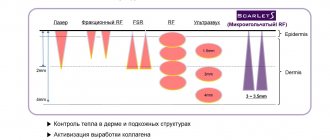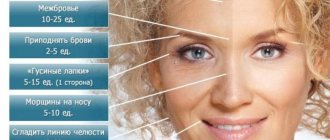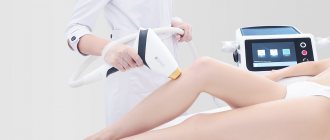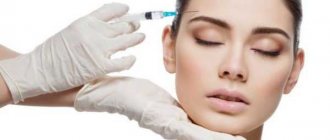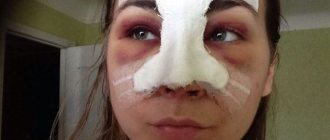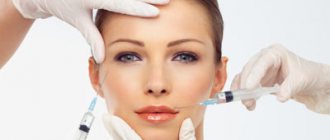How long after administration will the effect take place?
The drug takes a certain time to work; the effect of the injection will not become noticeable a few minutes after it is administered.
To properly distribute under the skin and gain strength, Botox will need at least 24-48 hours.
The exact time when the drug begins to work depends on several factors:
- Treatment zones.
- Insertion depths.
- Concentrations of substances in the drug.
- Features of the body.
Who is the procedure contraindicated for?
Botulinum is essentially a type of poison, so it must be used with great caution. The procedure should be rescheduled if on the day of the session your menstruation began, your temperature rose, or an exacerbation of a chronic disease occurred. You should avoid the procedure altogether if you have at least one of the following ailments:
- poor blood clotting;
- chronic diseases of the lungs, kidneys and liver;
- drooping eyelids;
- high myopia;
- neuromuscular disorders;
- intolerance to individual components of the drug.
It is also not recommended to administer injections during pregnancy or planning it. The toxin can negatively affect the fetus.
How many days after injections are results visible?
Experts believe that botulinum neurotoxin type A begins to work on the third day after administration.
The maximum result from injections with the drug becomes noticeable after two weeks , when it is evenly distributed in all areas where it was injected.
The effect of Botox lasts for 5-7 months. We wrote more about how long the result lasts in this article.
How to regain youth?
Despite the desperate desire to prolong the youth of her skin, not every woman wants to go under the knife. This is probably why botulinum therapy services have been the most popular in cosmetology for 20 years. This is an invasive technique that uses Botox, a drug you've probably heard about. “Injections of Youth” are extremely popular among Hollywood stars and Russian socialites. But if 20 years ago only celebrities could rejuvenate themselves with Botox therapy, today this technique is available to almost every woman.
Can the effect come sooner or later?
How quickly the effect of drug injections manifests itself strongly depends on certain characteristics of the body, whether the person has any bad habits, and how voluminous and powerful the muscle fibers are.
Cosmetologists have not noted cases where Botox began to show results earlier. There were situations when the drug began to act a day after the injection. During this period, botulinum toxin managed to block the nerve endings from which impulses go to the muscle fibers.
The only thing that can delay the effect of Botox and ruin it is failure to follow the special instructions of the cosmetologist after the injections. After “beauty injections” you must refuse :
- Physical impact on the points where botulinum toxin was injected.
- Washing with hot water and visiting a bathhouse or sauna (we discuss here why you should not visit a bathhouse after the procedure).
- Adopting a horizontal position less than 4-5 hours after injection.
Playing sports (read about when you can play sports after Botox injections here).- Active facial expressions.
- Drinking alcohol (the combination of Botox and alcohol is written in a separate article).
Also, the fact that the effect of Botox appears earlier or later is influenced by such factors as:
- The quality of the drug itself.
- The body's susceptibility to botulinum toxin.
- Qualification of a cosmetologist.
- Depth of wrinkles.
It is worth noting that there is a small percentage of people who are immune to the drug , so they do not experience results from Botox injections at all.
Termination of exposure
The mobility of the blocked muscles remains for some time, and then is gradually restored. This happens because neurons exposed to the toxin form new processes that can again synthesize acetylcholine. Thus, the broken connection between nerves and muscles is restored.
In addition, there are substances that can react with Botox drugs and partially neutralize their effect. Accordingly, the result will last less.
If the patient’s facial expressions are too active or he plays sports, then neural connections are restored even faster, and the duration of Botox is reduced to 2-3 months.
How to determine that the drug has “started” and started working?
Not long ago, there was an opinion that after the injection of botulinum toxin, the face turns into a motionless mask; by these sensations, a person understood that the drug had begun to act.
Indeed, the connection of this substance with the nerves occurs almost instantly.
Today, “beauty injections” are a very popular procedure, and cosmetologists have learned to select the required dosages of the drug with maximum precision , so the effect of the mask on the face is practically not felt. You can only understand that Botox has started to work by trying to tense the muscles of your face, but this will lead to nothing, since they will remain motionless and the skin will not gather in folds.
Is Botox harmful?
When used correctly, serum with the Botox effect is completely harmless to the human body. Complications can only arise if amateurs get down to business. If the toxin is administered incorrectly or the dosage is incorrect, facial asymmetry, drooping eyebrows, swelling and hematomas may occur. Therefore, it is extremely important to carefully choose a clinic. Harm to health can occur solely due to the incompetence of the doctor.
Note! A competent specialist will not see you without a detailed medical history to make sure there are no contraindications.
What to do if side effects occur?
Botulinum neurotoxin type A is a medical drug, so instead of providing anti-aging results, it may cause side effects in a small percentage of patients.
The most common negative reactions of the body occur :
- Swelling, bruising, pain at the injection sites. These symptoms go away on their own after a couple of days.
- Drooping of the eyelid, with this phenomenon, the eyes may stop opening completely or partially.
- The appearance of migraines, nausea and vomiting, dizziness.
- Facial asymmetry can appear if the work is done incorrectly by a cosmetologist. This phenomenon is eliminated along with the removal of Botox from the body, after about three months or longer.
- Paralysis of muscles exposed to the drug. This side effect often occurs due to incorrect dosages of botulinum toxin to be administered.
If you are not satisfied with the effect of “beauty injections” and do not like it for any reason, then you should contact the cosmetologist who performed the procedures or a doctor.
The effect of the drug can be neutralized with the help of tablets (antibiotics) prescribed by a specialist. How to remove Botox from your face if an undesirable effect occurs is described in this article.
In addition to the fact that the result after Botox injections can be negative, some patients also note its absence at all.
The effect may not be observed for the following reasons:
- The cosmetologist's recommendations after the procedure were not followed.
- A person has an individual intolerance to the drug.
- The patient is over 60 years old, the tone of wrinkles at this age is greatly reduced.
- Incorrect dosage or improper storage.
Also, before carrying out procedures, you should make sure that there are no contraindications to them.
Manifestation of the effect
Immediately after administration of the drug, slight swelling may remain at the injection site. It usually disappears completely within a few hours. And then nothing seems to happen for some time. But in fact, important processes have already been launched and on about the third day the effect of Botox will appear.
You can understand that the drug has already gained its strength by trying to tense the facial muscles in the area of its administration. If you look in the mirror, you can see that even with great effort they still remain relaxed. And over the next two weeks the effect only intensifies.
How long do injections last?
According to statistics, on average, Botox injections last from 3 to 6 months. Although today long-acting preparations have appeared on the market, which, with proper skin care, can maintain the effect for up to one year:
- Lantox is an inexpensive but quite effective Chinese analogue of Botox, which has been on the market for about 10 years. Its main disadvantage is quite severe swelling and bruising after injection. Duration of exposure – up to 9 months.
- "Xeomin" is a product of the famous German company. It allows you to maintain maximum mobility of facial expressions due to the thorough purification of the toxin from protein inclusions. But due to the mild impact, the result can only be enjoyed for 3-4 months.
- “Dysport” was originally created by French scientists as a therapeutic drug for neurological patients. It has been used successfully for more than 20 years, including as a remedy for hyperhidrosis. The result appears after 10-14 days and lasts up to 7 months.
The original drug was created in the late 90s by American scientists. Since then it has been improved several times, but is still capable of blocking the muscles for no more than 6-8 months.
Important Factors
In some cases, no effect of Botox is observed at all. This happens in people with very strong immune systems. Protective cells immediately recognize the toxin and neutralize it within a few minutes after injection.
The drug will not work on those who have already had botulism or have been vaccinated against it - their bodies already have antibodies that block its effects.
In addition, the effectiveness of Botox drugs is influenced by:
- Metabolism. At a high metabolic rate, even with a well-manifested effect of the drug, it will not last long.
- Depth of insertion. If deeply located muscle groups are blocked, then the visible result appears a little later - about 3-4 days. With superficial exposure – already on the second day after the injections.
- Amount of drug. The larger the dose of botulinum toxin administered, the faster its effect appears.
- Insertion accuracy. It is important that the specialist who performs the injections knows the anatomy of the facial muscles in detail. This allows you to make injections very precisely, blocking only the areas responsible for the formation of wrinkles, while maintaining natural facial expressions.
- Lifestyle. The degree and duration of the effects of Botox are directly influenced by bad habits (especially frequent alcohol consumption), the level of physical activity and the regularity of other cosmetic procedures.
It is difficult to get good results when smoothing a face with powerful muscles. This problem often occurs in men who are seriously involved in sports. Injections in the forehead, neck and chin rarely produce significant visual effects.
Smoothing out wrinkles
No one can say exactly how many days after Botox affects facial wrinkles. First of all, much depends on their depth and the amount of the drug used. It is also very important to understand the mechanism of skin restoration after its administration.
Facial folds appear due to the fact that when muscles contract, the skin breaks deeply. If facial expressions are active or regeneration processes are already slowed down, then the upper layer of the epidermis does not have time to smooth out naturally. To give him this opportunity, Botox is injected.
Blocked muscles lose their ability to contract. Accordingly, the skin no longer gathers in folds and gradually begins to even out.
Within a few months, the upper layer of the epidermis is almost completely replaced by new cells. Wrinkles become much less noticeable. And if the course of treatment is repeated, they may smooth out completely.
Treatment of hyperhidrosis
Hyperhidrosis can occur as an independent disease or result from a disruption in the normal functioning of the body. It is often a symptom:
- endocrine problems;
- presence of tumors;
- severe stress;
- acute poisoning;
- alcohol or drug addiction;
- viral infections;
- heart diseases.
Increased sweating often occurs in obese people. It is often provoked by poor nutrition, when the diet contains too much spicy and/or salty food, caffeine, hot food and alcoholic drinks.
Botox injections are a symptomatic treatment. They are not able to remove the cause of the problem, but they can significantly reduce fluid secretion by blocking the sweat glands. In this case, the neural connection between them and the brain is disrupted, which can no longer send appropriate signals.
Is it possible to finish off Botox after a month? How often can and should you inject botulinum toxin preparations?
In the most general case, Botox can be injected as often as the need arises.
Simply put, as soon as a person has wrinkles or other defects that were eliminated after a previous botulinum therapy procedure, he can be given injections again.
On a note
It is incorrect to say here that a person “needs” to inject Botox. There is no urgent need for its cosmetic use - if the patient has wrinkles again, he can walk with them for as long as he likes, and carry out the subsequent procedure whenever he wishes. We can talk about necessity when it is critically important for a person that wrinkles or other defects do not appear again.
However, some restrictions exist.
For example, Botox should be injected no earlier than two weeks after the first procedure, since such additional injection is carried out in the same muscles as during the first procedure, if it did not give a complete result. However, any cosmetic manipulations, especially invasive ones, after injections are allowed no earlier than 10 days. Therefore, Botox can be injected into the same areas at intervals of at least 2 weeks.
If injections are planned to be given to different parts of the body, then the interval here, in the absence of generalized side effects, may be absent altogether. For example, if after injections in the forehead there is no allergy or flu-like syndrome, you can inject the drug into the neck, shoulders or legs the very next day.
If side effects from the administration of botulinum toxin do not appear, then the drug can be injected into other problem areas the very next day.
On a note
All of the above is true only for the cosmetic use of Botox. In medical practice, the frequency of its use in a particular patient is determined by the specific disease, its severity and the speed of recovery of symptoms after the procedure. In this case, only a doctor can decide how often the patient needs to inject Botox. The important thing here is that for medical indications, regular botulinum therapy is necessary, while for cosmetic use it is carried out only at the request of the patient.
In general, if we are talking about injections of Botox and its analogues, then they need to be injected approximately every 7-10 months. Dysport injections have to be repeated every 5-7 months.
Also, sometimes after the procedure it becomes necessary to “finish off” Botox if, for safety reasons, the doctor used too small an amount of the product the first time and the effect was not fully manifested. Such “finishing” can be carried out on days 12-14, and this interval is determined not so much by safety considerations as by the need to evaluate the full effect after the first procedure. On about 10-12 days this can be done: the effect of the drug is fully manifested and possible side effects of the drug, which may hide part of the result, disappear.
An interesting point: cosmetology practice shows that the longer a person regularly injects Botox, the longer the effect remains after each subsequent procedure and the less often he needs to repeat these procedures. This is true for most (though not all) patients under the age of 50-60 years.
Practice shows that in most patients under the age of 50, the effect of repeated Botox injections becomes longer each time.
Contraindications to rejuvenation measures using Botox
Despite the relative safety of botulinum toxin itself, injection correction is not performed for the following conditions and diseases:
- pregnancy, breastfeeding (injections are not given six months before planning pregnancy);
- any inflammatory processes on the face;
- autoimmune pathologies;
- individual intolerance to the components of the drug;
- dysfunction of the kidneys, liver, heart.
Wrinkle correction is not performed on women over 60 years of age due to the high risk of ptosis, jowls, during the active phase of the menstrual cycle, and with muscle hypotonicity of various natures. With weak muscle tone, the administration of the drug further reduces muscle activity, asymmetry and tissue sagging develop.
How often can injections be given?
The frequency of correction is determined by the degree of elimination of the drug from the body. With the initial introduction of a paralyzing substance, correction is required after 8 months, as botulinum toxin is eliminated. During secondary injection therapy, correction is required after 3–4 months, but no more than 4–5 times a year. In this way, it is possible to provide a prolonged result that will keep the muscles in a relaxed state for about 3 years.
With frequent use of botulinum toxin injections, the sensitivity of the skin and neuromuscular structures increases. The drug dissolves quickly, and correction is required more and more often. In such a scenario, the need for Botox is questionable, and radical methods to eliminate age-related changes may be required.
Negative result
Consequences or complications from injections are not at all uncommon; they cannot be excluded even with the high professionalism of the doctor. The thing is that it is impossible to predict how the substance will be distributed, what the response of a particular muscle structure will be to the effects of botulinum toxin. Complications caused by the administration technique are usually limited to facial redness, the formation of papules, pain, swelling, facial asymmetry due to improper distribution of the substance within the neuromuscular chains. Common complications not related to the work of a cosmetologist are:
- headaches, up to the development of migraines;
- sagging of the outer corner of the eyes, eyebrows;
- facial asymmetry;
- double vision, increased intraocular pressure;
- changes in muscle activity in the lip area;
- lumps and papules in the injection area.
There is always a risk of infection after injection correction, which is why it is so important to carry out high-quality antiseptic treatment of the face. Any complications require attention, so if discomfort or external defects occur, you should consult a doctor.
Injections with a drug based on botulinum toxin are an effective and quick method of correcting age-related changes, however, the duration of the effect is strictly limited and is determined by the individual characteristics of the body. The procedure is carried out only after assessing the condition of the dermis and the potential risks from the procedure.
How long does the effect of Botox last?
The question of how long the effect of beauty injections lasts cannot be answered universally. The duration of the drug’s effect is always individual, which is associated not only with age and the depth of facial wrinkles, but also with the nature of metabolic processes, the patient’s weight, biochemical reactions in the body, lifestyle and habits, and clinical history. On average, the result lasts up to 8–10 months.
Sometimes patients need repeated correction after 14 days, which is due to the peculiarity of the responsiveness of some muscles to botulinum toxin. If the dose is calculated correctly and the rules of administration are followed, the drug has a maximum effect within 6 months.
